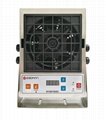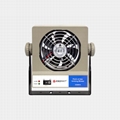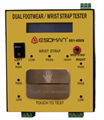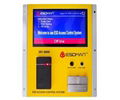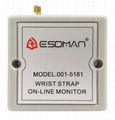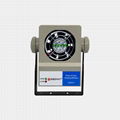| Model: | 001-9802 |
|---|---|
| Brand: | ESDMAN |
| Origin: | Made In China |
| Category: | Electronics & Electricity / Other Electrical & Electronic |
| Label: | 001-9802 , ESDMAN , Resistance Meters |
| Price: |
US $930
/ pc
|
| Min. Order: | 1 pc |
| Last Online:20 Jul, 2022 |
Overview:
001-9802 surface resistance/resistivity meter is designed according to ANSI/ESD S20.20, IEC61340-5-1, JESD 625-B, CECC, ASTM & UL test rules. It is used to measure all conductive, anti-static and dissipative material’s resistivity and ground resistance. It is easy to use and has high reliability. Applications include engineering, maintenance, quality control, incoming inspection, manufacturing and training.
Technical Parameters:
1. Measured resistance: 10e3-10e12ohm / surface resistivity: 10e3-10e12ohm / square
2. Measured temperature range: 32°F-100°F ( 0°C-37.8°C )
3. Measured humidity range: 10%-90%RH ( over 65%RH will affect accuracy )
4. Display: LCD display
5. Testing voltage: 10V (measured resistance <10e6)/100V (measured resistance > 10e6)
6. AC adapter: Input:120V AC or 220V AC
Output:12V DC
7. Power supply: DC or battery, it’s used in China and overseas ( external power supply and battery can’t be used together )
8. Electrode: two conductive touched area diameter is 63.5 mm±0.25 mm ( 2.5’’±0.1’’)
9. Weight: 2.27 kg±0.06 kg ( 5lbs ±2 oz )
10. Size: 191mm×102mm×39mm
11. Automatic power-off function to extend battery life
12. Automatic return to zero function for continuous and quick test.
13. Accuracy
10V accuracy
10E+3 - 10E+4: +/-9%@RH<90%
10E+4 - 10E+6: +/-5%@RH<90%
100V accuracy
10E+6 - 10E+8: +/-5%@RH<90%
10E+9 - 10E+10: +/-9%@RH<60%
10E+10 - 10E+11: +/-15%@RH<50%
10E+11 - 10E+12: +/-25%@RH<40%
Measurement Method:
1. When testing, especially for high resistance materials, make sure that the test wires do not touch or overlap
2. For accurate testing, operator couldn’t touch the electrode by hand during operation
3. The meter should be grounded with equipped ground cord during operation
4. The surface resistance of insulative plate should be larger than 1.0x 10e12 ohm when insulative plate need to be used during testing.
5. It is recommend to calibrate electrode each month, place the two electrodes on the metal plate and the measured resistance shoulder lower than 1000 ohm
a. Measure surface resistivity - parallel electrode
It can be used to measure the resistance of surface uniform materials and multilayer materials quickly
1. Make the meter to be placed on the object surface, 2 parallel bar need to touch object surface
2. Dial the switch to 10V voltage and press the test button keeping 5-10 seconds until the testing result is stable. If the
resistance is lower than 1.0 x 10 e6 ohm, please record the result. If the resistance is equal or larger than 1.0 x 10e6
ohm, please switch to 100V and test again
3. Switching the test voltage to 100 volts may result in a resistance reading less than 1.0x10e6 ohm. When this occurs, use the reading of the 100 volt test voltage.
4. When test surface resistance, humidity and temperature will be displayed on the LCD screen
5. The testing value will be shown after releasing the test button 15 sec.
6. Surface resistance is ohm
b. Measure surface resistance( point to point ) -2 five lbs weight
1. Plug each terminal of the 2 connecting cord into the 3.5mm jacks and the other end connected to 2 five lbs weights.
2. Make the 2 five lbs to be shown on the measured material surface, the distance between the 2 five lbs weights is 1 meter or the farthest distance that two weights can be separated on the surface of an object
3. Dial the switch to needed voltage 10V or 100V
4. Press the test button until testing result is stable
5. The test shall include areas of the surface that are easily worn or visibly soiled
6. Surface resistance is ohm
c. Measure surface resistance ( concentric ring probe ) optional
1. Plug each terminal of the connecting cord into the 3.5mm jacks and the other end connected to concentric ring probe.
2. Dial the switch to needed voltage 10V or 100V
3. Make the probe to be shown on the measured material surface, press the test button keeping 5-10 seconds until the testing result is stable
4. The test shall include areas of the surface that are easily worn or visibly soiled
5. Surface resistance is ohm
d. Measure volume resistance- 2 five lbs weights
1. Plug the 2 connecting cord into the 2 five lbs weights and the other end connected to meter.
2. Make one weight on the measured object surface
3. Make the other weight on the metal plate, like below picture
4. Dial the switch to needed voltage 10V or 100V
5. Press the test button to record the resistance after the meter is stable or 15 sec later.
6. The test shall include areas of the surface that are easily worn or visibly soiled
7. Volume resistance is ohm.
e. Measure Point to Grounding Point resistance-2 five lbs weight
1. Plug one cord terminal into the five lbs weight and the other end to meter. Make the 5 lb weight into the testing surface center
2. Connect the other cord terminal to meter and the other terminal to grounding reference point
3. Dial the switch to needed voltage 10V or 100V. Press the test button to record the resistance after the meter is stable or 15 sec later
4. The test shall include areas of the surface that are easily worn or visibly soiled
5. Point to grounding point resistance is ohm.
